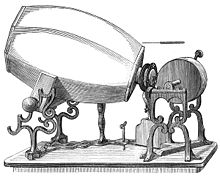Au clair de la lune recording

In 1860,FrenchinventorÉdouard-Léon Scott de Martinvillemade the earliest known sound recording, capturing himself singing the Frenchfolk song"Au clair de la lune."This recording went largely unnoticed and was overshadowed byThomas Edison'sphonograph,which famously recorded "Mary Had a Little Lamb."However, in March 2008, researchers rediscovered Scott de Martinville's recording and sent it to theLawrence Berkeley National Laboratory,where they used a computer program to convert it into audible sound.[1][2][3]
Overview
[edit]Sound engineersat theLawrence Berkeley National Laboratoryinitially played the phonautograms received fromFirst Soundsin March 2008 at a speed that resulted in a 10-second snippet, which seemed to feature a woman or child singing or humming a tune. Later, researchers discovered that a misinterpretation of a reference frequency had led to the playback speed being doubled. Once corrected, it became apparent that the recording was likely of a man, probably the inventorÉdouard-Léon Scott de Martinvillehimself, singing the Frenchfolk song"Au clair de la lune"at a slow pace.[4]
History
[edit]1853 or 1854-1860
[edit]In 1853 or 1854,FrenchinventorÉdouard-Léon Scott de Martinvilleconceived the idea of creating asound reproductionsystem after studying a diagram of thehuman ear.Inspired by this, he began developing what he termed "le problème de la parole s’écrivant elle-même" ( "the problem of speech writing itself" ), aiming to replicate the ear's capacity to capture and reproduce sound.[5][2]
On 25 March 1857, Scott de Martinville patented his device, which he called the "phonautograph."[6][7]
By 1857, with support from theSociété d’encouragement pour l’industrie nationale,the phonautograph had advanced to a point where it could record sounds with sufficient accuracy. This development led to its adoption by the scientific community for various studies and experiments.[2]
On 9 April 1860, Scott de Martinville recorded himself singing the Frenchfolk song"Au clair de la lune"(" By the Light of the Moon ") using his invention, the phonautograph. Unlike later devices, Scott de Martinville's phonautograph was not designed to replay recordings. Instead, it capturedsound wavesvisually on paper, allowing for the visualization of sound vibrations, which he called phonautograms.[8][1]
2008
[edit]
Before March 2008, it was widely believed thatThomas Edison'sphonographwas the first sound reproduction system. However, in March 2008, phonautograms created by Édouard-Léon Scott de Martinville were discovered and revived byFirst Sounds,an informal collaborative of American audio historians, recording engineers, and sound archivists. The phonautograms were subsequently sent toLawrence Berkeley National Laboratory,where the sound waves and vibrations were converted into audible sounds. This process achieved what Scott de Martinville had not incorporated into his original invention.[8][3]
Sound engineersinitially played the phonautograms at a speed that resulted in a 10-second snippet, which seemed to feature a woman or child singing or humming a tune. Later, researchers discovered that a misinterpretation of a reference frequency had led to the playback speed being doubled. Once corrected, it became apparent that the recording was likely of a man, probably of the inventor Édouard-Léon Scott de Martinville himself, singing the French folk song "Au clair de la lune" at a slow pace.[4]
References
[edit]- ^ab"Sound Recording Predates Edison Phonograph".All Things Considered.March 27, 2008.Archivedfrom the original on May 26, 2022.RetrievedJuly 13,2022– viaNPR.
- ^abc"First Sounds".FirstSounds.ORG.2008-03-27.Archivedfrom the original on December 31, 2017.Retrieved2017-05-24.
- ^abJody Rosen (March 27, 2008)."Researchers Play Tune Recorded Before Edison".The New York Times.Archivedfrom the original on July 1, 2017.RetrievedFebruary 23,2017.
- ^ab"Earliest Known Sound Recordings Revealed".U.S. News & World Report.
- ^"Origins of Sound Recording: The Inventors".National Park Service.July 17, 2017.Archivedfrom the original on January 22, 2022.RetrievedJuly 13,2022.
- ^Villafana, Tana (December 20, 2021)."Observing the Slightest Motion: Using Visual Tools to Preserve Sound".Library of Congress.Archivedfrom the original on January 3, 2022.RetrievedJuly 13,2022.
- ^Schoenherr, Steven E. (1999)."Leon Scott and the Phonautograph".University of San Diego.Archived fromthe originalon February 7, 2018.RetrievedJuly 13,2022.
- ^ab"Oldest recorded voices sing again".BBC News.March 28, 2008.Archivedfrom the original on April 17, 2022.RetrievedJuly 13,2022.

